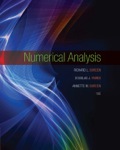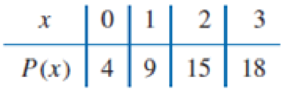
EBK NUMERICAL ANALYSIS
10th Edition
ISBN: 9781305465350
Author: BURDEN
Publisher: YUZU
expand_more
expand_more
format_list_bulleted
Concept explainers
Textbook Question
Chapter 3.3, Problem 12ES
The following data are given for a polynomial P(x) of unknown degree.

Determine the coefficient of x3 in P(x) if all fourth-order forward differences are 1.
Expert Solution & Answer
Want to see the full answer?
Check out a sample textbook solution
Students have asked these similar questions
Suppose an experiment was conducted to compare the mileage(km) per litre
obtained by competing brands of petrol I,II,III. Three new Mazda, three new
Toyota and three new Nissan cars were available for experimentation. During the
experiment the cars would operate under same conditions in order to eliminate
the effect of external variables on the distance travelled per litre on the assigned
brand of petrol. The data is given as below:
Brands of Petrol Mazda Toyota Nissan
I 10.6 12.0 11.0
II 9.0 15.0 12.0
III 12.0 17.4 13.0
(a) Test at the 5% level of significance whether there are signi
cant differences among the brands of fuels and also among the cars. [10]
(b) Compute the standard error for comparing any two fuel brands means. Hence
compare, at the 5% level of significance, each of fuel brands II, and III with
the standard fuel brand I. [10] �
Business discuss
Use the method of undetermined coefficients to solve the given nonhomogeneous system.X' =
−1 33 −1
X +
−4t2t + 2
X(t) =
Chapter 3 Solutions
EBK NUMERICAL ANALYSIS
Ch. 3.1 - For the given functions f(x), let x0 = 0, x1 =...Ch. 3.1 - Use Theorem 3.3 to find an error bound for the...Ch. 3.1 - Prob. 4ESCh. 3.1 - The data for Exercise 6 were generated using the...Ch. 3.1 - Prob. 9ESCh. 3.1 - Prob. 10ESCh. 3.1 - Prob. 11ESCh. 3.1 - Prob. 12ESCh. 3.1 - Prob. 15ESCh. 3.1 - Prob. 17ES
Ch. 3.1 - It is suspected that the high amounts of tannin in...Ch. 3.1 - Prob. 21ESCh. 3.1 - Prove Taylors Theorem 1.14 by following the...Ch. 3.1 - Prob. 1DQCh. 3.1 - If we decide to increase the degree of the...Ch. 3.2 - Let P3(x) be the interpolating polynomial for the...Ch. 3.2 - Nevilles method is used to approximate f(0.4),...Ch. 3.2 - Nevilles method is used to approximate f(0.5),...Ch. 3.2 - Suppose xj = j, for j = 0, 1, 2, 3, and it is...Ch. 3.2 - Nevilles Algorithm is used to approximate f(0)...Ch. 3.2 - Prob. 11ESCh. 3.2 - Prob. 13ESCh. 3.2 - Can Nevilles method be used to obtain the...Ch. 3.3 - Use Eq. (3.10) or Algorithm 3.2 to construct...Ch. 3.3 - Use Eq. (3.10) or Algorithm 3.2 to construct...Ch. 3.3 - Use the Newton forward-difference formula to...Ch. 3.3 - Use the Newton forward-difference formula to...Ch. 3.3 - Use the Newton backward-difference formula to...Ch. 3.3 - Use the Newton backward-difference formula to...Ch. 3.3 - a. Use Algorithm 3.2 to construct the...Ch. 3.3 - a. Use Algorithm 3.2 to construct the...Ch. 3.3 - a. Approximate f(0.05) using the following data...Ch. 3.3 - The following data are given for a polynomial P(x)...Ch. 3.3 - The following data are given for a polynomial P(x)...Ch. 3.3 - The Newton forward-difference formula is used to...Ch. 3.3 - Prob. 14ESCh. 3.3 - Prob. 16ESCh. 3.3 - Prob. 17ESCh. 3.3 - Show that the polynomial interpolating the...Ch. 3.3 - Prob. 20ESCh. 3.3 - Prob. 21ESCh. 3.3 - Prob. 22ESCh. 3.3 - Prob. 23ESCh. 3.3 - Compare and contrast the various...Ch. 3.3 - Is it easier to add a new data pair using...Ch. 3.3 - Prob. 3DQCh. 3.4 - Use Theorem 3.9 or Algorithm 3.3 to construct an...Ch. 3.4 - Use Theorem 3.9 or Algorithm 3.3 to construct an...Ch. 3.4 - The data in Exercise 1 were generated using the...Ch. 3.4 - The data in Exercise 2 were generated using the...Ch. 3.4 - Let f (x) = 3xex e2x. a. Approximate f (1.03) by...Ch. 3.4 - The following table lists data for the function...Ch. 3.4 - a. Show that H2n + 1 (x) is the unique polynomial...Ch. 3.4 - Prob. 1DQCh. 3.4 - Prob. 2DQCh. 3.4 - Prob. 3DQCh. 3.5 - Determine the natural cubic spline S that...Ch. 3.5 - Determine the clamped cubic spline s that...Ch. 3.5 - Construct the natural cubic spline for the...Ch. 3.5 - Construct the natural cubic spline for the...Ch. 3.5 - The data in Exercise 3 were generated using the...Ch. 3.5 - Prob. 6ESCh. 3.5 - Prob. 8ESCh. 3.5 - Prob. 11ESCh. 3.5 - Prob. 12ESCh. 3.5 - Prob. 13ESCh. 3.5 - Prob. 14ESCh. 3.5 - Given the partition x0 = 0, x1 = 0.05, and x2 =...Ch. 3.5 - Prob. 16ESCh. 3.5 - Prob. 21ESCh. 3.5 - Prob. 22ESCh. 3.5 - Prob. 23ESCh. 3.5 - It is suspected that the high amounts of tannin in...Ch. 3.5 - Prob. 29ESCh. 3.5 - Prob. 30ESCh. 3.5 - Prob. 31ESCh. 3.5 - Prob. 32ESCh. 3.5 - Let f C2[a, b] and let the nodes a = x0 x1 xn...Ch. 3.5 - Prob. 34ESCh. 3.5 - Prob. 35ESCh. 3.6 - Let (x0, y0) = (0,0) and (x1, y1) = (5, 2) be the...Ch. 3.6 - Prob. 2ESCh. 3.6 - Prob. 5ESCh. 3.6 - Prob. 1DQ
Knowledge Booster
Learn more about
Need a deep-dive on the concept behind this application? Look no further. Learn more about this topic, subject and related others by exploring similar questions and additional content below.Similar questions
- 5) You are purchasing a game for $30. You have a 5% off coupon and sales tax is 5%. What will your final price be? Does it matter if you take off the coupon first or add in the tax first? 6) You have ten coupons that allow you to take 10% off the sales price of a jacket, and for some strange reason, the store is going to allow you to use all ten coupons! Does this mean you get the jacket for free? Let's really think about what would happen at the checkout. First, the teller would scan the price tag on the jacket, and the computer would show the price is $100. After the teller scans the first coupon, the computer will take 10% off of $100, and show the price is $90. (Right? Think about why this is.) Then after the teller scans the second coupon, the computer will take 10% off of $90. (a) Continue this reasoning to fill in the table below showing the price of the jacket (y) after you apply x coupons. (b) Make a graph showing the price of the jacket from x = 0 to x = 10 coupons applied.…arrow_forwardDetailed report without CHATGPT, accept if you can give with code and plots, previous reported . Do not waste my question.arrow_forwardPlease do not give inappropriate solutions, previous question reported, i need correct report solution for this, NO CHATGPTarrow_forward
- Need detailed report without CHATGPT, accept if you can give with code and plots, previous reported Plots are required.arrow_forwardNeed detailed report without CHATGPT, accept if you can give with code and plots, previous reportedarrow_forwardWhat would you say about a set of quantitative bivariate data whose linear correlation is -1? What would a scatter diagram of the data look like? (5 points)arrow_forward
- 1. Which set of parametric equations is shown in the graph below? Explain your reasoning. a) x = t; y = t² b) x = = t²; y = t -3-2-1 5 4 3 2 1 12 3 2. Using the graph of f, a. determine whether dy/dt is positive or negative given that dx/dt is negative and b. determine whether dx/dt is positive or negative given that dy/dt is positive. Explain your reasoning. 2 f x 1 2 3 4arrow_forwardFind the perimeter of the triangle. Express the perimeter using the same unit of measure that appears on the given sides. 9 ft 13 ft 6 ft The perimeter isarrow_forwardUse the formula for Pr to evaluate the following expression. 9P5 9P5 =☐arrow_forward
- Find the volume of the figure. The volume of the figure is 3 m 3 m 3 marrow_forwardFind the circumference and area of the circle. Express answers in terms of and then round to the nearest tenth. Find the circumference in terms of C= (Type an exact answer in terms of x.) Find the circumference rounded to the nearest tenth. C= Find the area in terms of A= (Type an exact answer in terms of x.) Find the area rounded to the nearest tenth. A= 10 cmarrow_forwardSox & Sin (px) dx 0arrow_forward
arrow_back_ios
SEE MORE QUESTIONS
arrow_forward_ios
Recommended textbooks for you
 College Algebra (MindTap Course List)AlgebraISBN:9781305652231Author:R. David Gustafson, Jeff HughesPublisher:Cengage Learning
College Algebra (MindTap Course List)AlgebraISBN:9781305652231Author:R. David Gustafson, Jeff HughesPublisher:Cengage Learning Trigonometry (MindTap Course List)TrigonometryISBN:9781337278461Author:Ron LarsonPublisher:Cengage Learning
Trigonometry (MindTap Course List)TrigonometryISBN:9781337278461Author:Ron LarsonPublisher:Cengage Learning College AlgebraAlgebraISBN:9781305115545Author:James Stewart, Lothar Redlin, Saleem WatsonPublisher:Cengage Learning
College AlgebraAlgebraISBN:9781305115545Author:James Stewart, Lothar Redlin, Saleem WatsonPublisher:Cengage Learning

 Algebra: Structure And Method, Book 1AlgebraISBN:9780395977224Author:Richard G. Brown, Mary P. Dolciani, Robert H. Sorgenfrey, William L. ColePublisher:McDougal Littell
Algebra: Structure And Method, Book 1AlgebraISBN:9780395977224Author:Richard G. Brown, Mary P. Dolciani, Robert H. Sorgenfrey, William L. ColePublisher:McDougal Littell

College Algebra (MindTap Course List)
Algebra
ISBN:9781305652231
Author:R. David Gustafson, Jeff Hughes
Publisher:Cengage Learning

Trigonometry (MindTap Course List)
Trigonometry
ISBN:9781337278461
Author:Ron Larson
Publisher:Cengage Learning

College Algebra
Algebra
ISBN:9781305115545
Author:James Stewart, Lothar Redlin, Saleem Watson
Publisher:Cengage Learning



Algebra: Structure And Method, Book 1
Algebra
ISBN:9780395977224
Author:Richard G. Brown, Mary P. Dolciani, Robert H. Sorgenfrey, William L. Cole
Publisher:McDougal Littell
Finding Local Maxima and Minima by Differentiation; Author: Professor Dave Explains;https://www.youtube.com/watch?v=pvLj1s7SOtk;License: Standard YouTube License, CC-BY